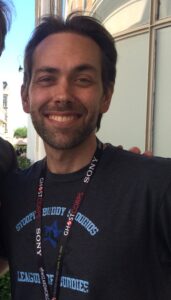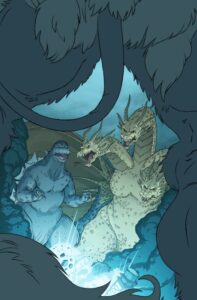When Dan Schoening was sitting in Camosun’s classrooms as a student, he probably couldn’t have imagined that his art would end up in some of the most popular comics in the world. But that’s exactly what’s happened, as his work has appeared in, among many others, Sonic the Hedgehog, Teenage Mutant Ninja Turtles, Godzilla, Batman, G.I. Joe, and Ghostbusters comics. Much of his work has been for IDW, one of the biggest publishers in comics today.
Schoening, a Camosun Visual Arts 1999 alumnus, moved to Vancouver to study animation in 2000, and from that point onwards has worked on animated television shows and several comics, most notably, a long-running series of Ghostbusters comics. Schoening says that while he’s always enjoyed drawing and animation, it was a certain groundbreaking 1983 video game that solidified his love for the art.
“I always had a love for animation. I grew up with the older Disney films from the ‘50s on up to the ‘80s, and those were a great inspiration,” says Schoening. “A huge inspiration was a video game called Dragon’s Lair, made by a few animators from Disney. I remember playing that in the ‘80s, it was expensive to play but it’s what inspired me to want to draw more.”

Schoening started off his animation career at the Vancouver Institute of Media Arts. Even before he had graduated, he was hired to do storyboarding work for television commercials, before moving to AKA Studios in Vancouver, working on the Cartoon Network show Ed, Edd, & Eddy. Eventually, he found himself back in Victoria, animating games for Disney, Pixar, and Fisher Price.
“[They were] mostly educational games, but it was great because my daughter was only four, so she could play-test all of them,” Schoening says, laughing. “So that was rewarding, to work on something that she could enjoy.”
Schoening, who says he stumbled into comic books by accident, says that while drawing comics, the background can be just as much of a character as the characters in the foreground, and recalls how, while working on Ghostbusters, he took great pains to be as faithful as possible while portraying the iconic city of New York.
“I was extremely meticulous about making sure the backgrounds were as accurate as possible; I considered New York its own character, and I wanted to make sure I was representing it properly,” he says. “I used Google Maps quite a lot, and it was cool, because you can go right down to the street level. If someone took a comic book that I did of Ghostbusters, and took it to that location in New York, it would be the identical image, almost.”
While many modern artists are fully digital, Schoening says he prefers the more tactile approach to traditional drawing and animation, because it lends a gritty, more visceral style to the finished product.
“I try and do everything traditionally. Everything I do is hand drawn, and then I scan it, and kind of compile it in Photoshop,” he says. “I just like hand drawing, it’s something I’ve grown up with, and there’s a bit of a disassociation in drawing with a Wacom tablet. I like using pencils and having that tactile feel, it’s something that you can’t emulate digitally, and I kind of like the roughness the pencil leaves on the page, rather than having it super clean.”

Schoening advises emerging artists to draw incessantly, and above all, foster an inextinguishable passion for the art, which really maximizes the chances of finding fulfilling career opportunities.
“I think the one piece of advice I always think of is just to draw every day, and to draw things that are challenging to draw,” he says. “Maybe more important than drawing every day is just to be passionate about it, and that can kind of apply to any profession that you want to do. If you really love doing it, you’ll always find a way to do it and to make a living out of it.”
A fascinating aspect of a good comic book panel is how a well-composed static image can create a sense of movement on the page, essentially creating an animation within the imagination of the reader.
“I’ve always thought that a good drawing suggests motion, like the reader can visualize that movement, if it’s a well-done drawing,” Schoening says. “I try and take that into consideration if I’m doing a panel or a splash page or something like that, just to make it visually interesting, but also thinking of anatomy and movement and perspective, and whether or not it fits into that style.”
Even the best artists have days where they feel frustrated, but Schoening says that persisting with a strong sense of determination will pay vast dividends in the future.
“There’s a bit of problem solving that goes into drawing, too, and being patient with yourself, and not to be too discouraged,” says Schoening. “Every artist has a different visual voice, so comparing yourself is probably the greatest thief of joy. But really, it’s your own kind of visual voice that will shine through, and it will take time to visually develop it. Just be patient, and draw lots.”
